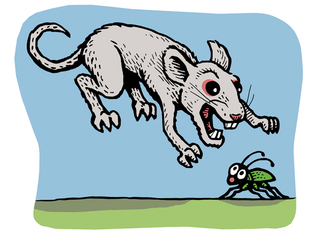 loading
loading
FindingsThe mice that roaredPulses of laser light turn mild Dr. Jekyll rodents into bloodthirsty Mr. Hydes.  Gregory NemecView full imageIn a rodent version of the Robert Louis Stevenson classic, Yale neurobiologist Ivan de Araujo and his colleagues have figured out how to turn a placid Dr. Jekyll mouse into a bloodthirsty Mr. Hyde mouse. Using a recently developed technique called optogenetics, the scientists delivered pulses of laser light into the brains of rodents—and completely altered their behavior. A mouse that had been indifferent to, or even afraid of, a toy or prey such as crickets would instantly transform into a relentless predator, bent on delivering a fatal bite. “We’re interested in understanding feeding behavior,” explains de Araujo, an associate professor of psychiatry at the medical school and a research fellow at the affiliated John B. Pierce Laboratory. With optogenetics, his team identified “the circuitry through which the complex computations in the brain involved in predation are implemented.” Based on studies by others, de Araujo had suspected that the central amygdala played a key role. “This region had been called the ‘fear center,’” he says, “and was thought to be involved in defensive behaviors, such as freezing, avoidance, and flight. But what we saw was completely different.” His team found two groups of neurons needed for a successful hunt: one that controls locomotion and puts the hunter in prey-pursuit mode, and another that works the muscles and jaw anatomy required to deliver that final bite. (The work is published in the journal Cell.) De Araujo says the team also found that the same two groups of neurons are present “in many different kinds of vertebrates—reptiles, birds, rodents, and primates, including us.” The circuitry doesn’t exist in jawless creatures like lampreys. But as jaws and their associated tissues evolved, says de Araujo, so did the neuronal command center: “The amygdala arose in a primordial set of animals to control a newly evolved set of muscles and bones that enabled vertebrates to hunt, then as now.”
The comment period has expired.
|
|